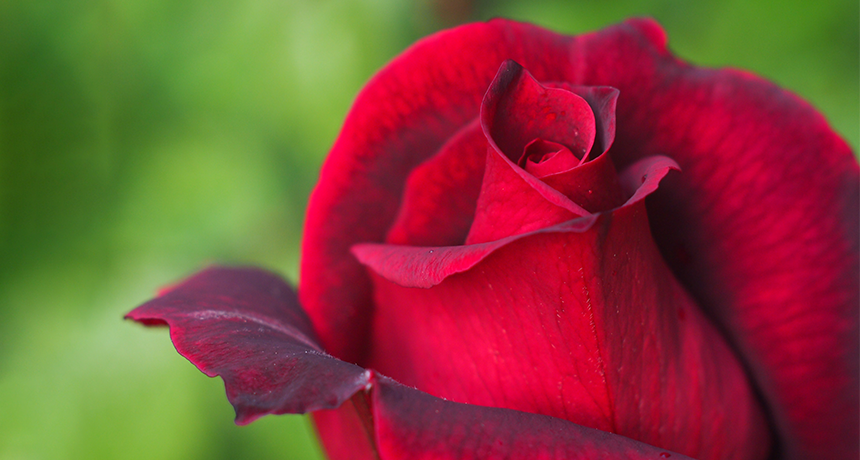Secret to rose scent surprises scientists
Knowing how the flowers make (and lose) their smell could help breeders grow sweeter blooms

Not all roses are sweetly scented. By comparing one that isn’t to this — the Papa Meilland rose (shown) — researchers discovered a surprising enzyme behind the bloom's signature “rose” scent.
TAKASHI .M/FLICKR (CC BY 2.0)
Share this:
- Share via email (Opens in new window) Email
- Click to share on Facebook (Opens in new window) Facebook
- Click to share on X (Opens in new window) X
- Click to share on Pinterest (Opens in new window) Pinterest
- Click to share on Reddit (Opens in new window) Reddit
- Share to Google Classroom (Opens in new window) Google Classroom
- Click to print (Opens in new window) Print
By Beth Mole
Stopping to smell the roses might be a letdown — and now researchers know why.
The sweet-smelling flowers create their scent using a surprising tool. It’s an enzyme — a hardworking molecule — that was thought to help clean up DNA. This enzyme is missing in many roses. And that seems to explain why their blooms also lack a sweet floral aroma. The new finding could help scientists solve the thorny problem of why some rose varieties bred for dazzling color and long-lasting blooms have lost their scent.
“Usually, the first thing that people do when they get [a rose] is smell it,” says Philippe Hugueney. He studies plant biochemistry at the National Institute for Agricultural Research (INRA) in Colmar, France. “Most of the time it’s not scented and it’s very disappointing,” he says.
When roses do smell like roses, it’s because they give off a distinct mix of chemicals, he says. Called monoterpenes, these chemicals can be found in many odorous plants. Monoterpenes come in different shapes and scents, but all have 10 atoms of the element carbon. In roses, these chemicals usually are floral and citrusy. But it was unknown how roses make — or lose — their scent.
Other plants make fragrance chemicals using specialized chemicals. Called enzymes, these molecules speed up chemical reactions without taking part in them. In flowers, these enzymes tend to snip two pieces off an unscented monoterpene to create a scented one.
But when Hugueney’s team compared smelly and smell-free roses, they discovered a different enzyme at work. Called RhNUDX1, It was active in the sweet-smelling roses but mysteriously shut down in the bland blooms. The scientists shared this discovery July 3 in Science.
RhNUDX1 is similar to enzymes in bacteria that remove toxic compounds from DNA. But in roses, the enzyme trims a single piece from an unscented monoterpene. Other enzymes in rose petals then finish the job by chopping off the last piece.
The discovery makes scientists wonder why roses use this unusual method, says Dorothea Tholl. She is a plant biochemist at Virginia Tech in Blacksburg. It may be because RhNUDX1 is more efficient than other enzymes, she says.
Hugueney hopes his team’s finding helps future roses come up smelling like — well, roses.
Power Words
(for more about Power Words, click here)
bacterium (plural bacteria) A single-celled organism. These dwell nearly everywhere on Earth, from the bottom of the sea to inside animals.
carbon The chemical element having the atomic number 6. It is the physical basis of all life on Earth. Carbon exists freely as graphite and diamond. It is an important part of coal, limestone and petroleum, and is capable of self-bonding, chemically, to form an enormous number of chemically, biologically and commercially important molecules.
compound (often used as a synonym for chemical) A compound is a substance formed from two or more chemical elements united in fixed proportions. For example, water is a compound made of two hydrogen atoms bonded to one oxygen atom. Its chemical symbol is H2O.
DNA (short for deoxyribonucleic acid) A long, double-stranded and spiral-shaped molecule inside most living cells that carries genetic instructions. In all living things, from plants and animals to microbes, these instructions tell cells which molecules to make.
element (in chemistry) Each of more than one hundred substances for which the smallest unit of each is a single atom. Examples include hydrogen, oxygen, carbon, lithium and uranium.
enzymes Molecules made by living things to speed up chemical reactions.
molecule An electrically neutral group of atoms that represents the smallest possible amount of a chemical compound. Molecules can be made of single types of atoms or of different types. For example, the oxygen in the air is made of two oxygen atoms (O2), but water is made of two hydrogen atoms and one oxygen atom (H2O).
monoterpene A type of molecule with 10 carbon atoms and 16 hydrogen atoms that may produce a scent.
toxic Poisonous or able to harm or kill cells, tissues or whole organisms. The measure of risk posed by such a poison is its toxicity.
variety (in agriculture) The term that plant scientists give to a distinct breed (subspecies) of plant with desirable traits. If the plants were bred intentionally, they are referred to as cultivated varieties, or cultivars.







